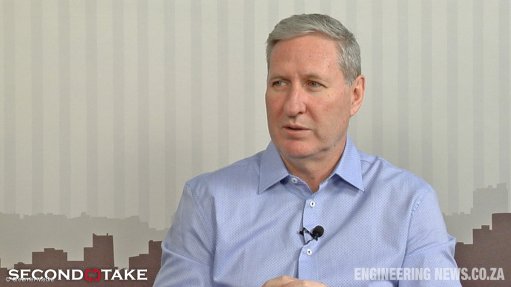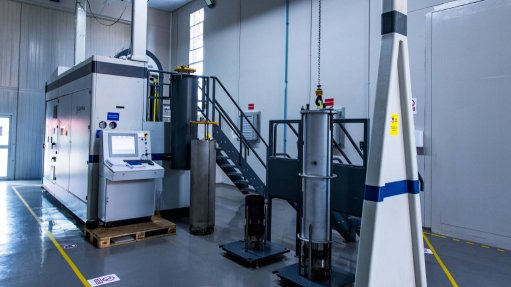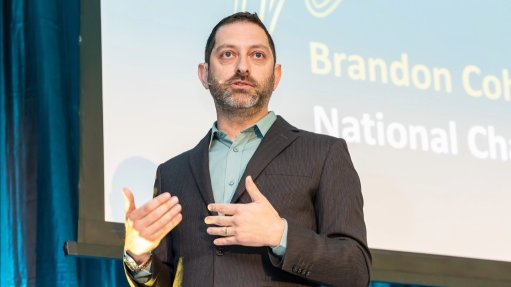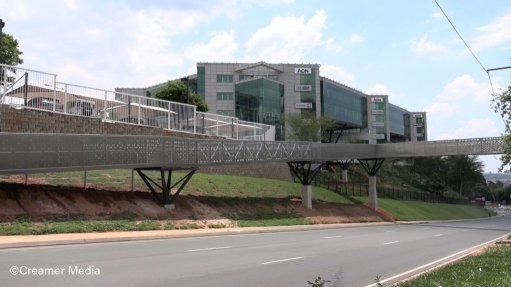Agri dept confirms HPAI vaccination trial, says strategy is taking shape

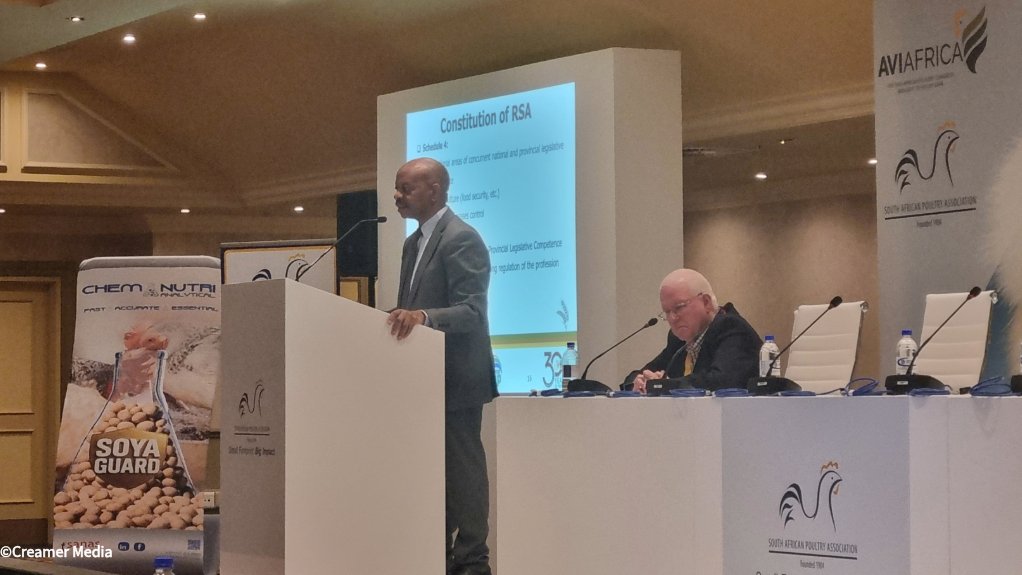
Agriculture deputy director general Dipepeneneng Serage
Photo by Creamer Media's Marleny Arnoldi
In recognising the importance of sustaining South Africa’s R72-billion poultry meat and R15.8-billion layer industries, both national and the Gauteng provincial governments are ramping up efforts to support small-scale and commercial companies in the sector through disaster management efforts and to grow local output.
During the continent’s largest poultry conference and exhibition, hosted by the South African Poultry Association (SAPA) from June 3 to 5, Gauteng Agriculture and Rural Development MEC Vuyiswa Ramakgopa and national Department of Agriculture deputy-director general Dipepeneneng Serage outlined efforts made and initiatives being planned to roll out vaccination in the industry and develop a national insurance mechanism.
The poultry sector managed to expand from a value of R59-billion in 2023 to R72-billion this year, following widespread outbreaks of two strains of Highly Pathogenic Avian Influenza (HPAI) that led to the industry culling 7.5-million broiler and layer chickens in 2023 The layer industry also recovered in value from R10.6-billion in 2023 to R15.8-billion this year.
South Africa’s chicken farmers produced more than 1.1-billion chickens in 2024, with a weekly average of 21.3-million birds being slaughtered, marking a 4.4% year-on-year increase compared with 2023. Chicken meat production totalled 1.83-million tonnes in 2024, compared with the 1.75-million tonnes produced in 2023.
As the second-largest agricultural sector in South Africa, the poultry industry offers valuable grain value chain sustainability; however, producers and processors have faced a myriad of challenges to operate profitably, including dumping, high input costs, infrastructure issues, a lack of compensation for birds culled during the HPAI crisis and ongoing difficulties in accessing HPAI vaccinations.
The Department of Agriculture insists that poultry producers undertake various biosecurity measures before they will allow vaccination of flocks and will still not compensate for birds having been culled. SAPA has initiated legal disputes in this regard, arguing that the procedures are onerous and expensive, and that not even the largest producers in South Africa can afford them.
With various vaccination negotiations having failed to produce an acceptable compromise, Serage assured delegates of AVI Africa that national government was advocating for vaccination against HPAI, as well as increased effort on traceability, surveillance and record-keeping in agricultural practices.
He mentioned that the department had often had challenges in geolocating farms and needed to first collaborate with universities and international scientists to perfect vaccination protocols.
So far, three H5 vaccines have been registered for use in South Africa while one H7 vaccine is under development and registration.
Serage confirmed that numbers and details were being finalised for an initial vaccination programme to be rolled out on one farm, during which the department would collect data on the number of doses administered and analyse together with third parties how it affected poultry flocks, including to see how the H5 strain may mutate.
He also stated that the Directorate Animal Health and industry representatives were refining the requirements of the HPAI vaccination strategy to make is as easy and affordable as possible without compromising on technical soundness.
Serage stressed that government could not undertake wide-scale HPAI prevention alone and encouraged farmers and agroprocessors to keep records, register for vaccination, ensure normal biosecurity measures were in place and aid in surveillance and control efforts during outbreaks.
Industry information is also required for the department to plan its resources, including the number of additional veterinarians that will be needed to administer vaccines.
He emphasised the importance of solidifying the science behind vaccination to ensure its effectiveness and continuous adaptation, which could only happen through collaboration and research.
Serage warned that vaccination would not be a replacement for biosecurity measures, but would instead complement the existing efforts in the industry to curb the lateral spread of HPAI during outbreaks.
He also warned that some of South Africa’s main trade partners in the Southern African Development Community had indicated they would not accept vaccinated chickens, their progeny or products from vaccinated birds, unless there was full traceability of all vaccinated birds from the time of the vaccine until slaughter, which producers needed to be mindful of.
SAPA, meanwhile, in February cautioned that culling of flocks alone was insufficient to prevent the spread of HPAI and called for vaccination as another tool to combat the spread of bird flu.
PROVINCIAL EFFORTS
Ramakgopa emphasised that the Gauteng government took concerns within the poultry sector very seriously, given that 25% of South Africa’s poultry production occurs in Gauteng.
She mentioned that the provincial government had spent more than R470-million through eight programmes to offer training, funding and other kinds of support for poultry farmers, particularly its Comprehensive Agricultural Support Programme.
The Gauteng provincial government has established various agriculture hubs offering abattoir and packaging facilities for poultry farmers, including in Tshwane and Sedibeng, as well as an egg packing facility in Mogale City, which currently serves 24 small-scale egg farmers.
Ramakgopa confirmed that her department was working on disaster relief mechanisms for provincial outbreaks of HPAI, including an early-warning system, while efforts were under way to establish a national insurance fund to secure the poultry industry during disease outbreaks.
She warned, however, that the concept was still in its early stages, with discussions focusing on cost implications and potential capitalisation models for such a fund.
“Both the provincial and national government are considering how to strengthen disaster protection,” Ramakgopa said, especially as the Poultry Sector Master Plan targeted that between 7% and 10% of local production be exported by 2028 and the fact that one in four households in Gauteng suffered from moderate to severe hunger.
She encouraged producers of all sizes to engage with the national department and provincial government to provide input and solutions for the industry’s growth and protection during outbreaks, as well as to take up the various support programmes on offer.
Ramakgopa further stressed the importance of training on biosecurity, business plans and smart poultry production methods, which should be a collaborative effort between larger producers, government and tertiary institutions.
She committed the Gauteng province to continue to invest in better surveillance, tighter controls and smarter early-warning systems to protect the poultry industry.
INTERNATIONAL VIEW
World Egg Organisation director-general Julian Madeley echoed Serage’s sentiment that vaccination should be a complementary tool to biosecurity measures.
For Madeley, there is an urgent global imperative to advance HPAI vaccination programmes owing to the disease’s increasing spread to other species including polar bears, pigs, sheep and cattle, as well as transmission to humans that have been recorded in recent years.
In April, Mexico reported the death of a young child owing to the HPAI H5 strain, while the US in January reported its first HPAI-related human death. Five human infections of HPAI were recorded in Cambodia in February 2024, with one person having died.
Brazil is currently faced with an outbreak of bird flu, which has prompted many countries, including South Africa, to temporarily halt imports of poultry and poultry products from that country, which is a significant global exporter.
This will not only have a financial impact on Brazil, but there has also been concern that the bird flu may spread to species other than chicken.
Madeley stressed that the H5 bird flu strain, in particular, continues to mutate and evolve, with vaccination helping ensure public, food and animal safety.
He mentioned that vaccination in the poultry sector globally was also backed by the World Organisation for Animal Health, which recently adopted a resolution to advocate for the use of strategic vaccination as a means for disease control.
Madeley illustrated the example of France having implemented a vaccination campaign since October 2023 targeting ducks.
The country managed to reduce the amount of HPAI outbreaks from 1 377 in 2021/22 to 402 in 2022/23 and, ultimately, ten and 15 in 2023/24 and 2024/25, respectively, achieving a 95% decrease in HPAI outbreaks.
Countries that already vaccinate against HPAI include Bolivia, Chile, China, Ecuador, Egypt, Indonesia, Mexico, Peru, Uruguay and the Philippines.
Madeley expected 2.4-billion laying hens to be vaccinated this year against both high pathogenic and low pathogenic avian influenza.
Article Enquiry
Email Article
Save Article
Feedback
To advertise email advertising@creamermedia.co.za or click here
Comments
Press Office
Announcements
What's On
Subscribe to improve your user experience...
Option 1 (equivalent of R125 a month):
Receive a weekly copy of Creamer Media's Engineering News & Mining Weekly magazine
(print copy for those in South Africa and e-magazine for those outside of South Africa)
Receive daily email newsletters
Access to full search results
Access archive of magazine back copies
Access to Projects in Progress
Access to ONE Research Report of your choice in PDF format
Option 2 (equivalent of R375 a month):
All benefits from Option 1
PLUS
Access to Creamer Media's Research Channel Africa for ALL Research Reports, in PDF format, on various industrial and mining sectors
including Electricity; Water; Energy Transition; Hydrogen; Roads, Rail and Ports; Coal; Gold; Platinum; Battery Metals; etc.
Already a subscriber?
Forgotten your password?
Receive weekly copy of Creamer Media's Engineering News & Mining Weekly magazine (print copy for those in South Africa and e-magazine for those outside of South Africa)
➕
Recieve daily email newsletters
➕
Access to full search results
➕
Access archive of magazine back copies
➕
Access to Projects in Progress
➕
Access to ONE Research Report of your choice in PDF format
RESEARCH CHANNEL AFRICA
R4500 (equivalent of R375 a month)
SUBSCRIBEAll benefits from Option 1
➕
Access to Creamer Media's Research Channel Africa for ALL Research Reports on various industrial and mining sectors, in PDF format, including on:
Electricity
➕
Water
➕
Energy Transition
➕
Hydrogen
➕
Roads, Rail and Ports
➕
Coal
➕
Gold
➕
Platinum
➕
Battery Metals
➕
etc.
Receive all benefits from Option 1 or Option 2 delivered to numerous people at your company
➕
Multiple User names and Passwords for simultaneous log-ins
➕
Intranet integration access to all in your organisation








